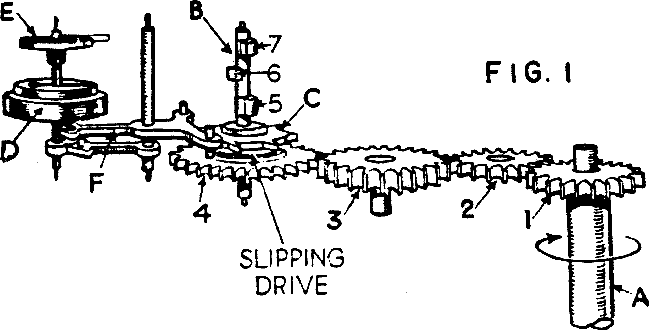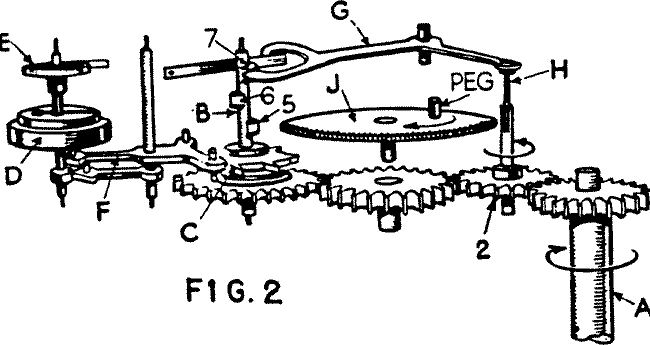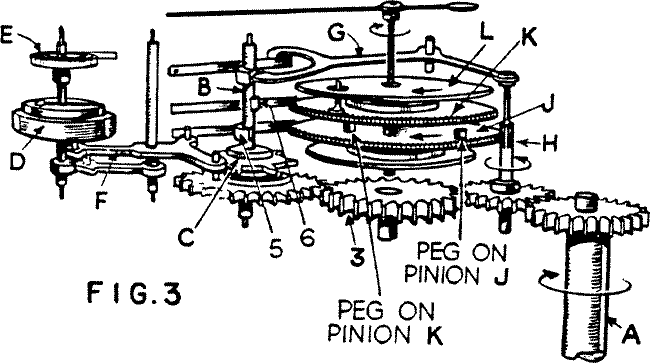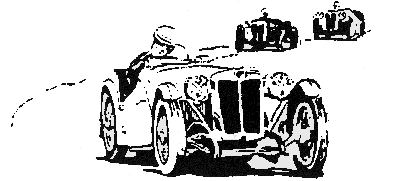

I recently came across a vintage car handbook that was published by the British "Autocar" magazine. Among the items of interest to the old car fan was a detailed account of the Jaeger tachometer and speedo mechanism. This was the instrument that was fitted as standard by Abingdon right up through our TCs and early TDs.
With this info in hand, I felt that an article would be of interest to the "TCers" who have been curious as to what goes on behind the dial when the slim needle does its ticky-tocky thing as we play with the shift lever and throttle.
The chronometric instrument was developed in France for aircraft use during the first world war. The rationale for using such a complex design lies in its ability to produce an absolutely precise speed indication. This accuracy (which the early day instruments couldn't match) made it a prime favorite for aircraft and racing cars where the RPM range is vital for performance and safety.
Because of its quality and accuracy, it was also used by many of the fine motor cars of the classic period such as Bentley, Bugatti, Hispano-Suiza, etc. and was also used from the beginning on the MG racing cars.
OPERATION
When you are scanning the schematic diagrams and their text, bear in mind that the instrument functions like a watch with an escapement governing the speed of the recording mechanism so that RPM indications are obtained at intervals of 3/4 second. In theory, therefore, the indicator needle moves in a series of "pulses" for a fraction of a second but in actuality the variation in RPM is so minute in that brief period that the readout indication on the needle is quite steady. Although the Jaeger mechanism is somewhat complex, it longevity and reliability is assured by its very modest input requirements of only 16U9 revs per minute per mile.
REGULATING ACTION (see Fig. 1)
Shaft A is driven by the engine or gearbox cable as indicated by the arrow. By means of the gear train (1 to 4), rotation is transmitted to the escapement wheel "C" and the camshaft "B". However, in as much as the only connection between wheel "C" and gear "4" is through a "slipping drive" clutch, the speed of the camshaft is kept constant by the balance wheel "D", its hair spring "F:" and escapement lever "F". This part of the mechanism works exactly like a watch.

Therefore, no matter at what speed the gear train is being driven by shaft "A", the camshaft "B" will only rotate at the speed permitted by the escapement. In other words, the "slipping drive" between escapement wheel "C" and gear "4" allows the drive to overrun so that the camshaft rotates at a fixed rpm regardless of the input speed from the engine or gearbox cable. It is important that this point be kept in mind since upon it depends the whole action of the instrument.

SPEED INPUT OPERATION (see Fig. 2)
Note that one end of the pivoted rocking lever "C" is held against cam "7" by a leaf spring. The right hand end of this lever is connected to spindle "H" whose central portion has a fine-cut gear meshing with the teeth of ratched pinion "J". Now due to the cam "&", the rocking lever "G" will be continually moving the central gear on the spindle in and out of engagement with the teeth on the periphary of pinion "J" and since the camshaft is moving at the speed set by the escapement, the spindle "H" will be moved in and out of mesh with pinion "J" at regular intervals. Now the spindle "H" is being rotated by gear "2" at input shaft speed and therefore during the period that its teeth are meshed with the ratched pinion "J", it will turn the pinion a greater or lesser degree according to the speed at which it's being driven by the input shaft "A" via gear "2"--- i.e. if the input shaft and the central gear on the spindle are turning at a high speed, the ratched pinion "J" will be moved a greater distance in a fraction of a second while the teeth are engaged with it than if the input shaft were rotating at a slower speed.

SPEED INDICATION (see Fig. 3)
Mounted on pinion "J" is a peg and when the pinion is driven round, this peg butts up against a similar peg on the bottom side of the recorder wheel "K". (It should be noted that both "J" and "K" are loose fits on their shaft and are not driven by gear "3") The recorder wheel "K" has another peg on its top surface which connects it to a third wheel "L" which has the indicating needle fastened to it. The top wheel "L" also acts as a dampner for the needle as there is a fourth leaf spring, (not shown) which bears lightly on the rim of "L" and damps out inertial (over-travel) effects on the needle due to speed changes.
As the speed input arrives from spindle gear "H" the pinion "J" is driven round a certain distance and it's peg butts against the peg on "K" and pushes it around. Both the pinion "J" and wheel "K" have hair springs which tend to return them to zero but they are checked alternately by leaf springs actuated at regular intervals by cams "5" and "6" on "B" (the R.H. ends of the leaf springs are formed to mesh with the teeth cut on the rim of wheels "J" and "K"). Now when the teeth on "H" comes out of mesh with pinion "J", "Js" leaf spring has just engaged the teeth on the rim and holds it fast. Meanwhile "Ks" leaf spring has been taken out of its engagement by cam "6", but "K" is held in position by the two pegs bearing against each other. The next movement is that cam "5" lifts "Js" spring and "Js" hair-spring tries to return it to zero, but just prior to this, the rotation of cam "6" has allowed the end of its leaf spring to engage with the rim teeth of pinion "K", so that "K" stands still and keeps the top wheel "L" on its indication through its upper peg. Then the teeth on "H" come back in mesh and starts to drive "J" and after a slight pause, "Ks" leaf spring lifts, releasing it.
Now if the input RPM has remained steady during the foregoing period of operation (which has only taken 3/4 of a second!---[but much longer to type --Ed.]) the peg on pinion "J" will catch up with the peg on wheel "K" and hold it in position until another cycle is started. If the input has increased, "Js" peg will carry "Ks" peg further and thereby move "L" and its needle to a higher reading. Inversely, if the RPM has decreased, "Js" peg will not be driven as far as the position occupied by "K" and "Ks" hair-spring will cause it to move back until the pegs meet once more.
The operation of the whole mechanism is thus governed by the escapement and as the teeth cut on spindle "H" are moved in and out of mesh at regular intervals, the needle on "L" is moved at those periods only. At all other times it is locked in position, and when it does move, it moves only the difference to correspond with any variation in RPM that has taken place in the last 3/4 second.
MAINTENANCE
The unit is of course akin to a watch in as much as a malfunction usually requires the services of a instrument specialist. Perhaps the main thing the owner can do is to make sure the drive cables are lubed. There are cable lubes which can be fed into the housing from the instrument end. This is usually carried out at the same time the generator gear box requires lubrication.
As a guide to the inveterate "do-it-yourselfer", our veteran original owner, Joe Douglass has kept his Jaeger units operative since his car was new. His approach is to take the mechanism from its case at two year intervals and clean and lubricate same. He uses Rislone oil on the pivot points and applys AC speedo grease to the rubbing points. However this method requires some knowledge of disassembly plus special tools and much patience.
Well, now that you are clued in on the "innerds" of the little calculator, here's hoping that when you next scan your tach and speedo, you give a little bow to the design and craftsmanship that keeps the needle true on its peripatetic mission, for in this present era of "black box", "solid state", "throwaway" and non-repairable items we shall not see the likes of the Jaegar again!
